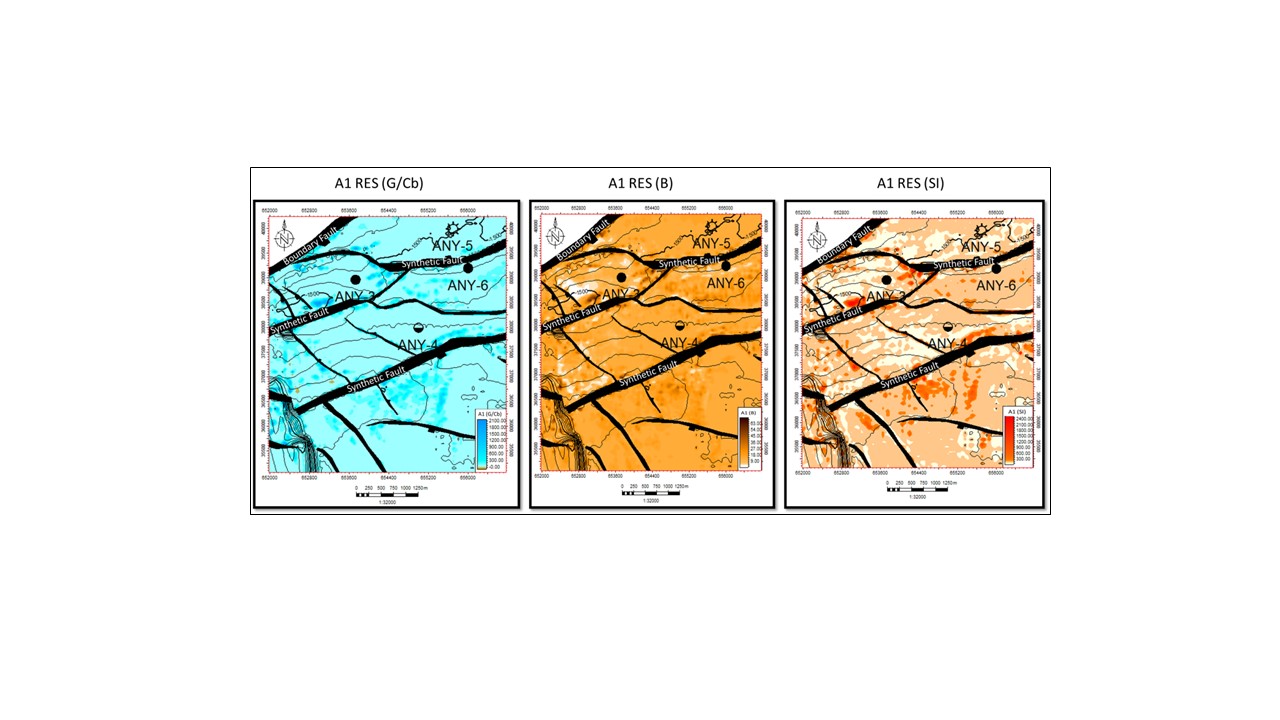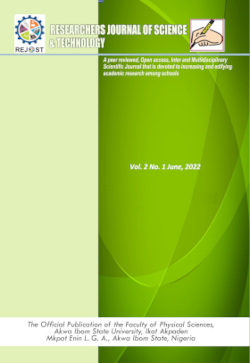Predictive Analysis of Sand Production and Flow Implications using Petrophysical-Geomechanical Properties: A case of “ANY” Field, Niger Delta
Keywords:
Sand production, Petrophysical properties, Geomechanical properties, Niger Delta, Wireline logsAbstract
A predictive analysis of sand production and flow implications using petrophysical-geomechanical properties: A case of the 'ANY' field, Niger Delta, was carried out. Datasets, including well logs and 3-D seismic, were used to investigate the geomechanical properties of the field and predict sand production based on the results obtained. Sand production is expected because the Niger Delta Province is predominantly a loose sandstone terrain, and the sand grains are highly friable. The study centers on employing empirical relationships of rock mechanical parameters from wireline logs to predict the vulnerability of the reservoir formations to sand production. The four reservoir units (A1, A2, A3, and A4) were first recognized by using wireline logs (gamma ray), and the fluids were differentiated using resistivity, neutron porosity, and density logs. We correlated the identified hydrocarbon prospecting sands across all three wells. Shear and compressive waves from the sonic log were then used to derive the rock mechanical parameters (Poisson ratio (ν), Young modulus (E), shear/rigidity modulus (G), bulk modulus (Kb), bulk compressibility (Cb), and unconfined compression strength (UCS)). Five sand production methods (porosity, acoustic wave travel time, sand production index (B), Schlumberger sand production index (SI), shear modulus to bulk compressibility ratio (G/Cb)) derived from the rock mechanical parameters were used to adequately analyze sanding. The analyzed reservoir exhibits sandstone units with a higher average value range of Poisson ratio, bulk modulus, Young’s modulus, shear modulus, and unconfined compression strength of 0.26 to 0.33, 15.29 to 20.90 MPa, 15.52 to 29.23 MPa, 5.84 to 11.56 MPa, and 22.45 to 29.23, respectively. The reservoirs exhibited higher values of the Poisson ratio, indicative of their ductile nature that is resulting from shale intercalations, which is evident in the moderate net to gross (NTG) ratio, leading to enhanced stiffness due to elevated moduli, hence less prone to deformation. The results of the five (5) predictions of sand production models indicate a very low risk of sanding during production of the investigated reservoirs. Thus, this research application of empirical relationships derived from rock mechanical parameters and wireline logs in predicting sand production has effectively deduced that the reservoirs in ANY field were highly compacted and consolidated, and therefore problems associated with sand production (sanding) during hydrocarbon extraction in this field are ruled out or almost unlikely.
References
Adeoye, T. O., Olatunji, B., & Olawale, D. (2020). Challenges and management of sand production in the Niger Delta reservoirs. Journal of Petroleum Exploration and Production Technology.
Akpan, A.S., Obiora, D.N., Okeke, F.N., Ibuot, J.C., and George, N.J., 2020a. Influence of wavelet phase rotation on post stack model based seismic inversion: A case study of X-field Niger Delta, Nigeria. Journal of Petroleum and Gas Engineering, UK, 11 (1), Pp. 57– 67. https:// doi.org/ 10.5897/ JPGE219.0320.
Akpan, A.S., Okeke, F.N., Obiora, D.N., and George, N.J., 2020b. Modelling and mapping hydrocarbon saturated sand reservoir using Poisson’s impedance (PI) inversion: A case study of Bonna field Niger Delta Swamp Depobelt, Nigeria. Journal of Petroleum Exploration and Production Technology
Akpan, M.J., George, N.J., Ekanem, A.M., and Nathaniel, E.U., 2022. Utilizing Probabilistic Neural Network for Reservoir Assessment: A Case Study from an Onshore Niger Delta Field. Researchers Journal of Science and Technology, 2 (3), Pp. 55–67.
Akpan, M.J., George, N.J., Ekanem, A.M., Ekong, U.N., 2022. Ekong Petrophysical appraisal and 3D structural interpretation of reservoirs in an Onshore Niger Delta Field, Southeastern Nigeria. International Journal of Energy and Water Resources, https://doi.org/10.-1007/s42108-022-00218-9.
Barefield, E., & Shakoor, A. (2006). The effect of degree of saturation on the unconfined compressive strength of selected sandstones. In Proceedings of the International Association for Engineering Geology and the Environment (IAEG) 2006 Conference (Paper No. 606). The Geological Society of London.
Bianlong, Z., Ma, D., Li, L., Juncheng, H. (2013). Application of Logging Data in Predicting Sand Production in Oilfield. Egyptian Journal of Petroleum, 18, 6173-6180.
Ebong, S.T., Aniekan, M., Ekanem, A.M., George, N.J., (2023). Reservoir Characterisation Using Seismic Inversion Techniques for Mapping of Prospects. Researchers Journal of Science and Technology, 3 (1), Pp. 1 – 13.
Ehsan K. & Ebrahim R. (2015). Sand production prediction using ratio of shear modulus to bulk compressibility (case study). Egyptian Journal of Petroleum Volume 24, Issue 2, June 2015, Pages 113-118.
George, N.J., Umoh, J.A., Ekanem, A.M., Agbasi O.E. Asfahani, J. Thomas J.E. (2022). Geophysical-laboratory data integration for estimation of groundwater volumetric reserve of a coastal hinterland through optimized interpolation of interconnected geo-pore architecture. J Coast Conserv 26, 56. https://doi.org/10.1007/s11852-022-00902-2
Horsfall, O.I., Akpan M.J. & George, N.J. (2024) Reservoir characterization of GABO field in the Niger Delta Basin using facies and petrophysical analyses, Results in Earth Sciences, Vol. 2,100038, https://doi.org/10.1016/j.r-ines.2024.100038
Ibrahim, S., Ehirim, C. N., & Etim, A. A. (2021). Geomechanical assessment of sand production in the Niger Delta. Journal of Petroleum Exploration and Production Technology.
Ogagarue, D.O. (2008). Localized VP − VS Relationships from the Niger Delta Sediments. The Pacific Journal of Science and Technology. 9 (2). 558 - 561.
Ortoleva, P., Ed. (1994). Basin Compartments and Seal rocks. Tulsa. American Association of Petroleum Geologists.
Osia, S. I., Ajibola, A. & Enemuoh, E. E. (2020). Predictive modeling of sand production in Niger Delta fields. SPE Nigeria Annual International Conference and Exhibition.
Santarelli, F. J., & Carminati, S. (1995). Predicting sand production in poorly consolidated reservoirs. Journal of Petroleum Science and Engineering.
Short, K. C., & Stauble, A. J. (1967). Outline of Geology of Niger Delta. AAPG Bulletin, 51(5), 761–779.
Tixier, M.P. Loveless, G.W. & Anderson, R.X. (1975) Estimation of the formation strength from the mechanical properties log. Journal of Petroleum Technology, 27, 283-293.
Tuttle, M. L. W., Charpentier, R. R., & Brownfield, M. E. (1999). The Niger Delta Petroleum System: Niger Delta Province, Nigeria, Cameroon, and Equatorial Guinea, Africa (Open-File Report 99-50-H). U.S. Geological Survey
Weber, K. J., &Daukoru, E. M. (1975). Petroleum Geology of the Niger Delta. Proceedings of the Ninth World Petroleum Congress, Volume 2, Geology, 209-221.
Vail, P. R. (1987). Seismic stratigraphy interpretation procedure. AAPG Studies in Geology, 27, 1–10.
Baker, R., Corbett, P., & Jiang, Z. (2015). Some rules of thumb for porosity cut-offs. ResearchGate. Retrieved from https://www.researchgate.net/figure/Some-rules-of-thumb-for-porosity-cut-offs-Baker-et-al-2015_tbl1_370141923
Phillips, S. (2007). Improving net–to-gross reservoir estimation with small scale heterogeneity analysis. Search and Discovery Article #40352. Retrieved from https://www.search and discovery-.com/documents/2007/07079phillips/images/phillips.pdf
Saboorian-Jooybari, H., & Kazemi, H. (2023). A comprehensive methodology for reservoir cut-off determination. Journal of Petroleum Exploration and Production Technology, 13, 123–145. https://doi.org/10.1007/s13202-023-01636-z
Opara, A. I., & Onuoha, K. M. (2009). Evaluation of formation susceptibility and sand production potential in Niger Delta oil reservoirs. Journal of Petroleum Science and Engineering, 70(3–4), 179–185.

Downloads
Published
How to Cite
Issue
Section
License
Copyright (c) 2025 Researchers Journal of Science and Technology

This work is licensed under a Creative Commons Attribution-NonCommercial-NoDerivatives 4.0 International License.




